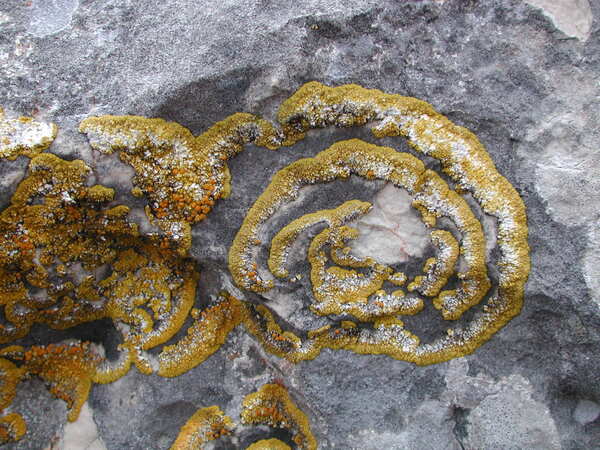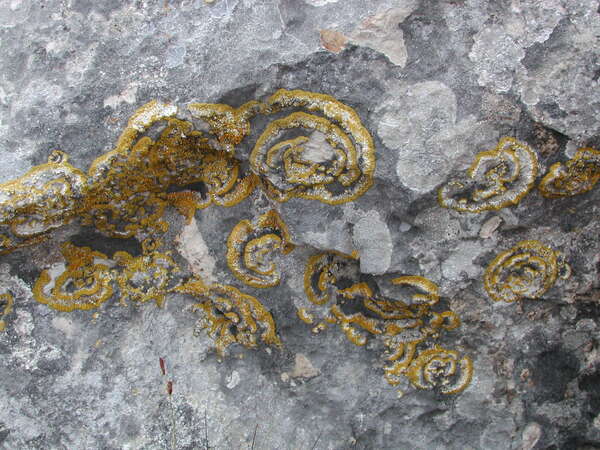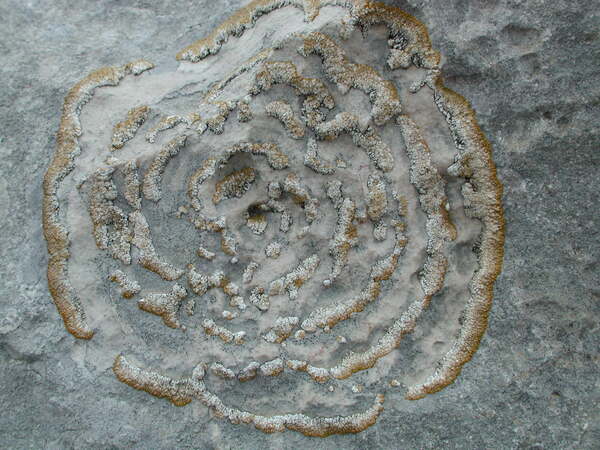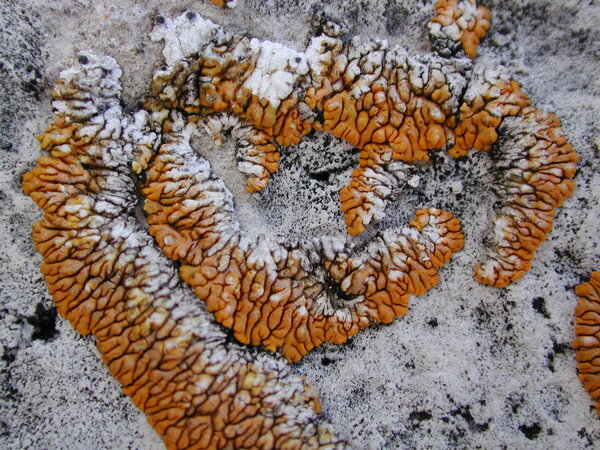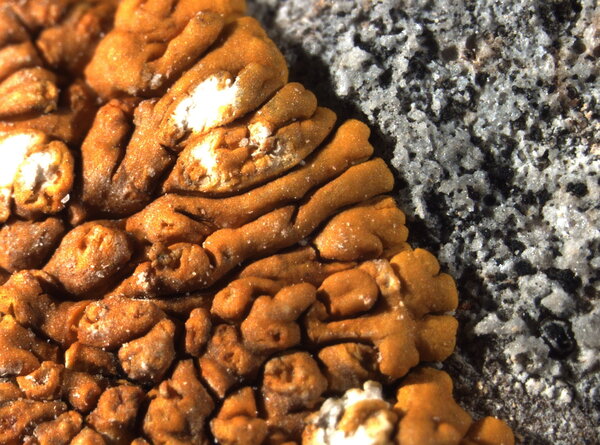Caloplaca anularis Clauzade & Poelt
Herzogia, 2: 305, 1972.
Synonyms: Caloplaca scrobiculata auct. eur. non H. Magn.
Description: Thallus crustose-placodioid, episubstratic, orange-yellow, to 400 μm thick, with a characteristic centrifugal growth: the thalli start dying and rapidly fall off 2-4 mm from the growing lobe-tips, leaving a 4-6 mm wide ring of 0.3-1 mm wide, contiguous, convex lobes, the free central part being often re-colonized by younger thalli, which produces a series of concentric rings; more rarely the thalli remain rosulate, in which case they produce apothecia. Upper cortex prosoplectenchymatous, 60-140 μm thick, the upper part with many small orange crystals of anthraquinones; medulla white, up to 200 μm thick, densely filled with colourless crystals visible under polarized light; algal layer 70-150 μm thick, continuous or sometimes interrupted by cortex cones extending downwards; lower cortex poorly developed, forming a sort of hypothallus. Apothecia zeorine, 0.5-1.2 mm across, with a more or less flat, orange-yellow disc and a thin, often finally excluded margin. Epithecium brownish orange, K+ purple-red: hymenium and hypothecium colourless. Asci 8-spored, clavate, functionally unitunicate, apically thickened with a broad internal beak, the inner part of apex and external cap I+ blue, Teloschistes-type. Ascospores 2-celled, polarilocular, hyaline, narrowly ellipsoid to narrowly rhomboid, (14-)15.5-17.5(-20.5) x (5-)5.7-7(-9) μm, the equatorial thickening (“septum”) (1.25-)1.6-1.9(-2.25) μm. Pycnidia immersed, orange. Conidia 3-4.5 x 1-1.5 μm. Photobiont chlorococcoid. Spot tests: thallus and apothecia K+ purple-red, C-, KC-, P-. Chemistry: thallus and apothecia with unidentified anthraquinones.
Growth form: Crustose placodiomorph
Substrata: rocks
Photobiont: green algae other than Trentepohlia
Reproductive strategy: mainly sexual
Commonnes-rarity: (info)
Alpine belt: rare
Subalpine belt: extremely rare
Montane belt: absent
Dry submediterranean belt: absent
Humid submediterranean belt: absent
Padanian area: absent
pH of the substrata:
1 2 3 4 5
Solar irradiation:
1 2 3 4 5
Aridity:
1 2 3 4 5
Eutrophication:
1 2 3 4 5
Poleotolerance:
0 1 2 3
Altitudinal distribution:
1 2 3 4 5 6
Rarity
absent
extremely rare
very rare
rare
rather rare
rather common
common
very common
extremely common
Loading data...
Occurrence data
Predictive map
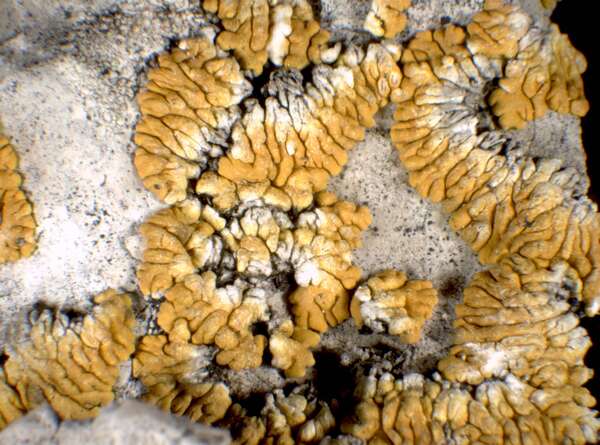
P.L. Nimis; Owner: Department of Life Sciences, University of Trieste
Herbarium: TSB (28042)
2001/12/07
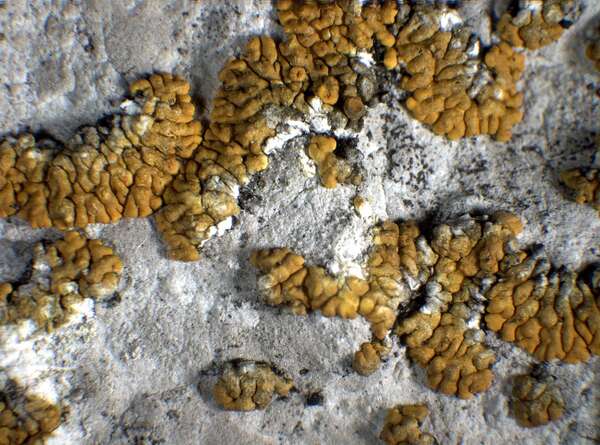
P.L. Nimis; Owner: Department of Life Sciences, University of Trieste
Herbarium: TSB (8217)
2001/11/12
Vezda Lich.Sel.Exs. 2077
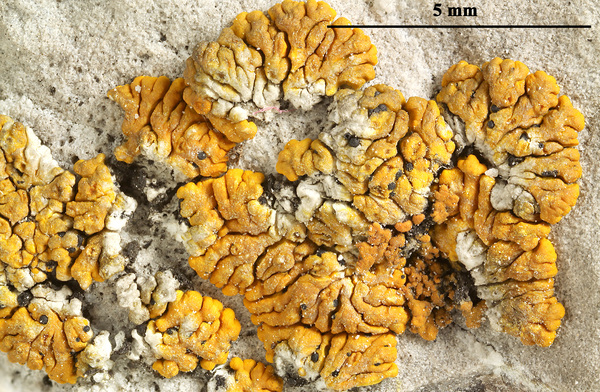
Felix Schumm - CC BY-SA 4.0
[19566], Bohemoslovacia, Slovacia, Carpates Centrales (Tatra Magna), iugum Belanské Tatry dictum, in monte Buja , alt. 1900 m, ad saxa calcarea venti exposita. Leg. E. Farkas, Z. Kyselová & A. V zda, 29.08.1985. VEZDA: LICHENES SELECTI EXSICCATI NR. 2077.
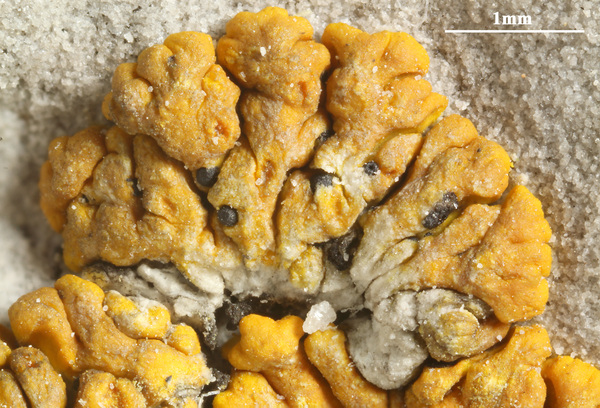
Felix Schumm - CC BY-SA 4.0
[19566], Bohemoslovacia, Slovacia, Carpates Centrales (Tatra Magna), iugum Belanské Tatry dictum, in monte Buja , alt. 1900 m, ad saxa calcarea venti exposita. Leg. E. Farkas, Z. Kyselová & A. V zda, 29.08.1985. VEZDA: LICHENES SELECTI EXSICCATI NR. 2077.
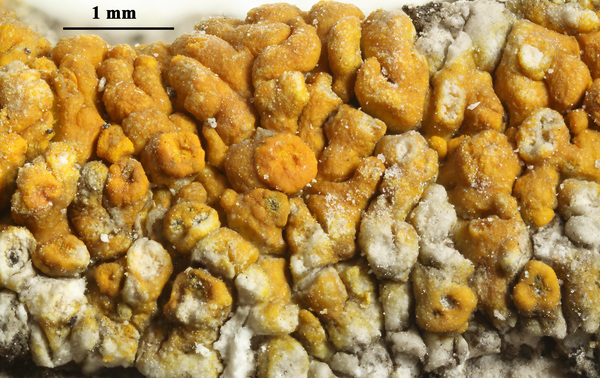
Felix Schumm - CC BY-SA 4.0
[19566], Bohemoslovacia, Slovacia, Carpates Centrales (Tatra Magna), iugum Belanské Tatry dictum, in monte Buja , alt. 1900 m, ad saxa calcarea venti exposita. Leg. E. Farkas, Z. Kyselová & A. V zda, 29.08.1985. VEZDA: LICHENES SELECTI EXSICCATI NR. 2077.

Felix Schumm - CC BY-SA 4.0
[19566], Bohemoslovacia, Slovacia, Carpates Centrales (Tatra Magna), iugum Belanské Tatry dictum, in monte Buja , alt. 1900 m, ad saxa calcarea venti exposita. Leg. E. Farkas, Z. Kyselová & A. V zda, 29.08.1985. VEZDA: LICHENES SELECTI EXSICCATI NR. 2077.
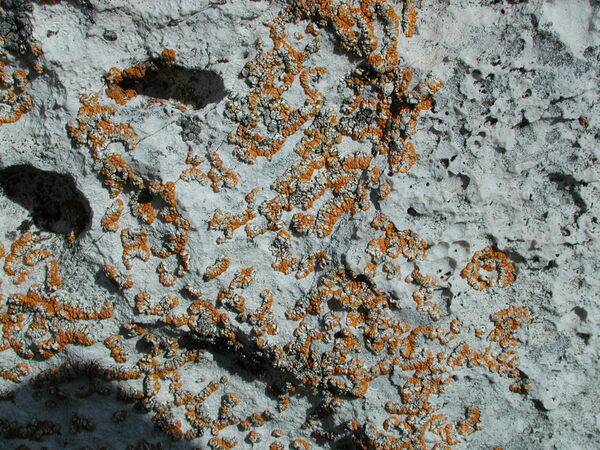
Juri Nascimbene - CC BY-SA 4.0; Owner: ITALIC - Dyades Project - Dept. of Life Sciences, University of Trieste
Italy, Trentino-Alto Adige, Bolzano/Bozen, Sciliar/Schlern
2007
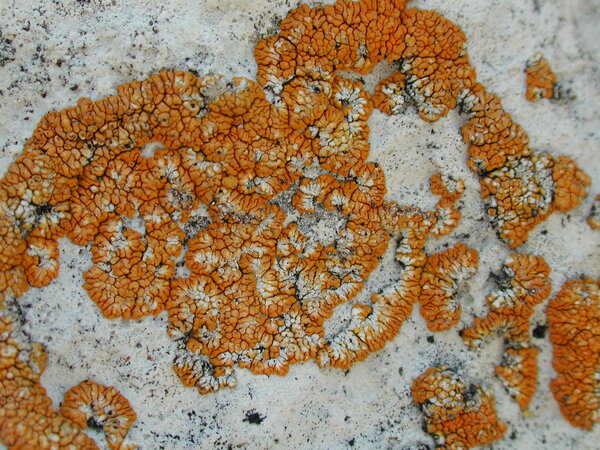
Juri Nascimbene - CC BY-SA 4.0; Owner: ITALIC - Dyades Project - Dept. of Life Sciences, University of Trieste
Italy, Trentino-Alto Adige, Bolzano/Bozen, Sciliar/Schlern
2007
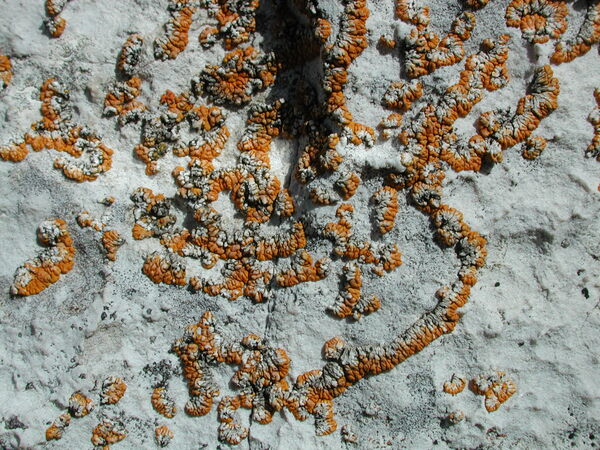
Juri Nascimbene - CC BY-SA 4.0; Owner: ITALIC - Dyades Project - Dept. of Life Sciences, University of Trieste
Italy, Trentino-Alto Adige, Bolzano/Bozen, Sciliar/Schlern
2007
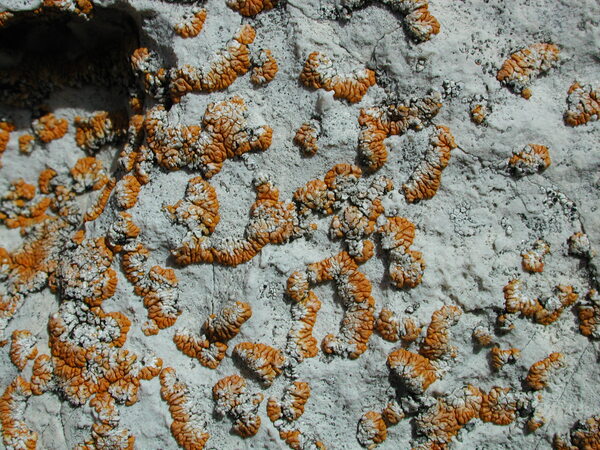
Juri Nascimbene - CC BY-SA 4.0; Owner: ITALIC - Dyades Project - Dept. of Life Sciences, University of Trieste
Italy, Trentino-Alto Adige, Bolzano/Bozen, Sciliar/Schlern
2007
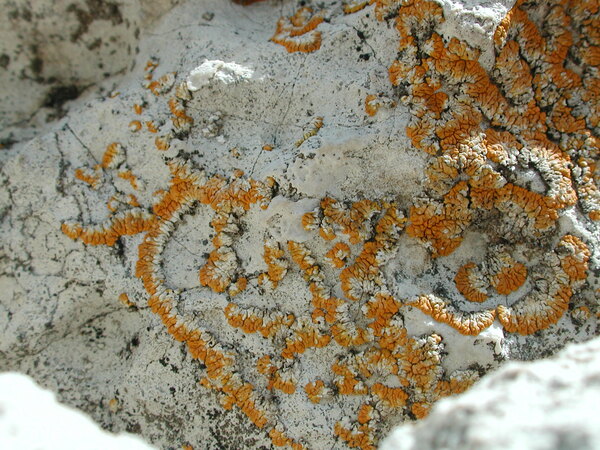
Juri Nascimbene - CC BY-SA 4.0; Owner: ITALIC - Dyades Project - Dept. of Life Sciences, University of Trieste
Italy, Trentino-Alto Adige, Bolzano/Bozen, Sciliar/Schlern
2007

Juri Nascimbene - CC BY-SA 4.0; Owner: ITALIC - Dyades Project - Dept. of Life Sciences, University of Trieste
Italy, Trentino-Alto Adige, Bolzano/Bozen, Sciliar/Schlern
2007
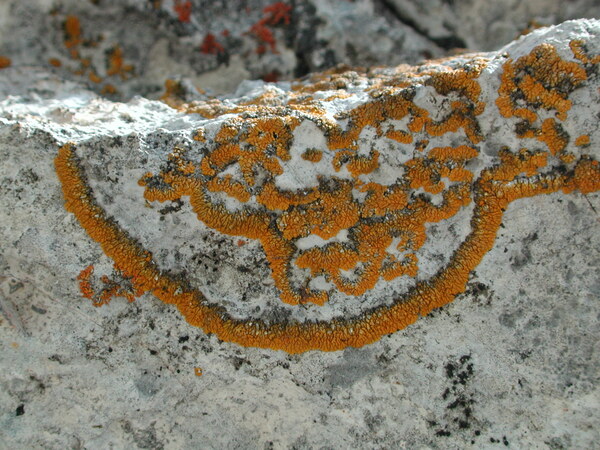
Juri Nascimbene - CC BY-SA 4.0; Owner: ITALIC - Dyades Project - Dept. of Life Sciences, University of Trieste
Italy, Trentino-Alto Adige, Bolzano/Bozen, Sciliar/Schlern
2007
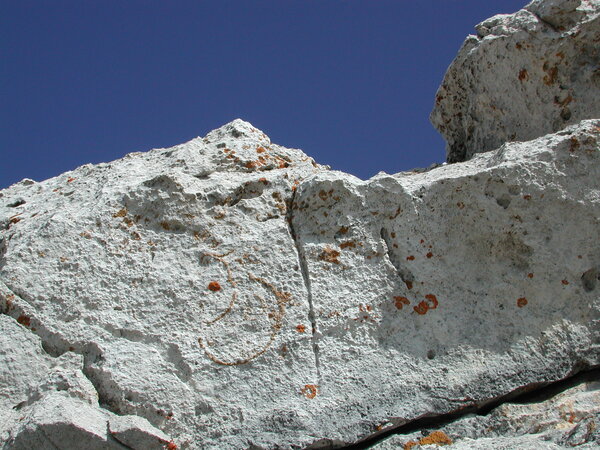
Juri Nascimbene - CC BY-SA 4.0; Owner: ITALIC - Dyades Project - Dept. of Life Sciences, University of Trieste
Italy, Trentino-Alto Adige, Bolzano/Bozen, Sciliar/Schlern
2007
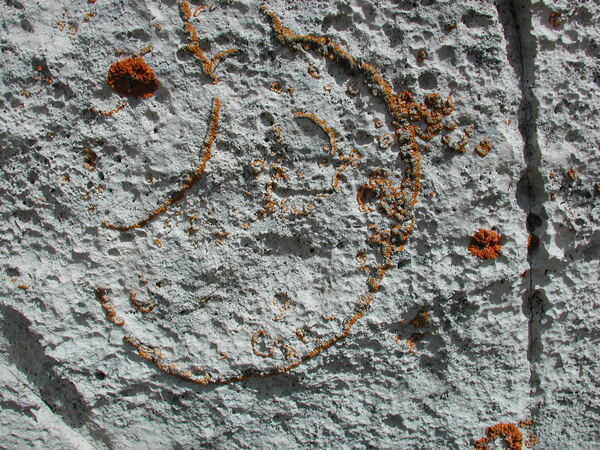
Juri Nascimbene - CC BY-SA 4.0; Owner: ITALIC - Dyades Project - Dept. of Life Sciences, University of Trieste
Italy, Trentino-Alto Adige, Bolzano/Bozen, Sciliar/Schlern
2007
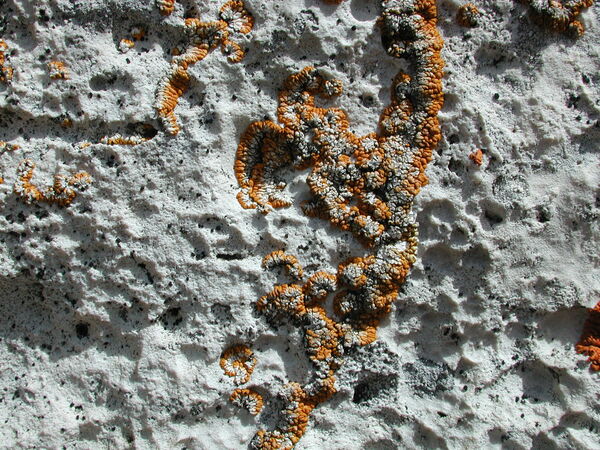
Juri Nascimbene - CC BY-SA 4.0; Owner: ITALIC - Dyades Project - Dept. of Life Sciences, University of Trieste
Italy, Trentino-Alto Adige, Bolzano/Bozen, Sciliar/Schlern
2007
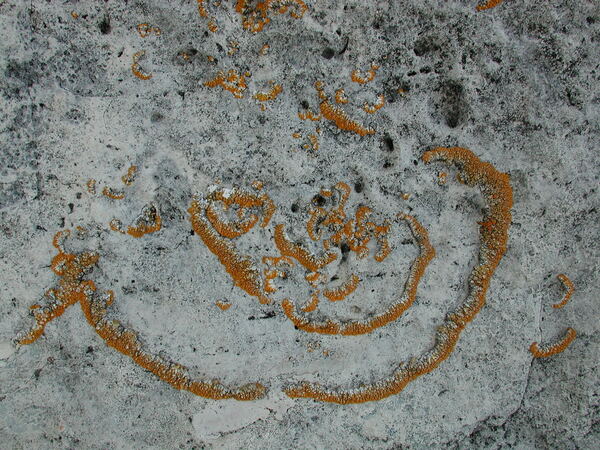
Juri Nascimbene - CC BY-SA 4.0; Owner: ITALIC - Dyades Project - Dept. of Life Sciences, University of Trieste
Italy, Trentino-Alto Adige, Bolzano/Bozen, Sciliar/Schlern
2007
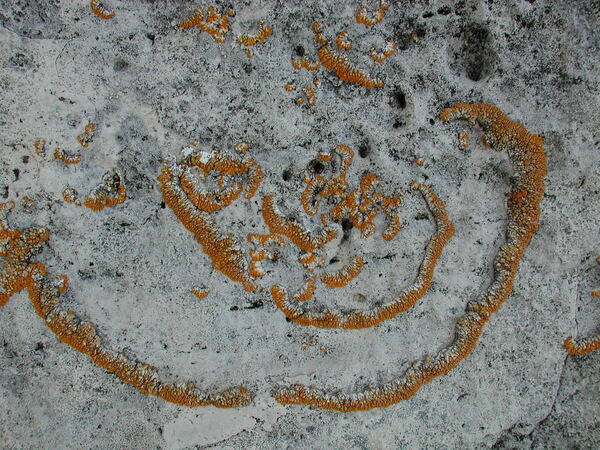
Juri Nascimbene - CC BY-SA 4.0; Owner: ITALIC - Dyades Project - Dept. of Life Sciences, University of Trieste
Italy, Trentino-Alto Adige, Bolzano/Bozen, Sciliar/Schlern
2007
Growth form: Crustose placodiomorph
Substrata: rocks
Photobiont: green algae other than Trentepohlia
Reproductive strategy: mainly sexual
Commonnes-rarity: (info)
Alpine belt: rare
Subalpine belt: extremely rare
Montane belt: absent
Dry submediterranean belt: absent
Humid submediterranean belt: absent
Padanian area: absent
pH of the substrata:
| 1 | 2 | 3 | 4 | 5 |
Solar irradiation:
| 1 | 2 | 3 | 4 | 5 |
Aridity:
| 1 | 2 | 3 | 4 | 5 |
Eutrophication:
| 1 | 2 | 3 | 4 | 5 |
Poleotolerance:
| 0 | 1 | 2 | 3 |
Altitudinal distribution:
| 1 | 2 | 3 | 4 | 5 | 6 |
Rarity
absent
extremely rare
very rare
rare
rather rare
rather common
common
very common
extremely common
Loading data...
Occurrence data
Predictive map

P.L. Nimis; Owner: Department of Life Sciences, University of Trieste
Herbarium: TSB (28042)
2001/12/07

P.L. Nimis; Owner: Department of Life Sciences, University of Trieste
Herbarium: TSB (8217)
2001/11/12
Vezda Lich.Sel.Exs. 2077

Felix Schumm - CC BY-SA 4.0
[19566], Bohemoslovacia, Slovacia, Carpates Centrales (Tatra Magna), iugum Belanské Tatry dictum, in monte Buja , alt. 1900 m, ad saxa calcarea venti exposita. Leg. E. Farkas, Z. Kyselová & A. V zda, 29.08.1985. VEZDA: LICHENES SELECTI EXSICCATI NR. 2077.

Felix Schumm - CC BY-SA 4.0
[19566], Bohemoslovacia, Slovacia, Carpates Centrales (Tatra Magna), iugum Belanské Tatry dictum, in monte Buja , alt. 1900 m, ad saxa calcarea venti exposita. Leg. E. Farkas, Z. Kyselová & A. V zda, 29.08.1985. VEZDA: LICHENES SELECTI EXSICCATI NR. 2077.

Felix Schumm - CC BY-SA 4.0
[19566], Bohemoslovacia, Slovacia, Carpates Centrales (Tatra Magna), iugum Belanské Tatry dictum, in monte Buja , alt. 1900 m, ad saxa calcarea venti exposita. Leg. E. Farkas, Z. Kyselová & A. V zda, 29.08.1985. VEZDA: LICHENES SELECTI EXSICCATI NR. 2077.

Felix Schumm - CC BY-SA 4.0
[19566], Bohemoslovacia, Slovacia, Carpates Centrales (Tatra Magna), iugum Belanské Tatry dictum, in monte Buja , alt. 1900 m, ad saxa calcarea venti exposita. Leg. E. Farkas, Z. Kyselová & A. V zda, 29.08.1985. VEZDA: LICHENES SELECTI EXSICCATI NR. 2077.

Juri Nascimbene - CC BY-SA 4.0; Owner: ITALIC - Dyades Project - Dept. of Life Sciences, University of Trieste
Italy, Trentino-Alto Adige, Bolzano/Bozen, Sciliar/Schlern
2007

Juri Nascimbene - CC BY-SA 4.0; Owner: ITALIC - Dyades Project - Dept. of Life Sciences, University of Trieste
Italy, Trentino-Alto Adige, Bolzano/Bozen, Sciliar/Schlern
2007

Juri Nascimbene - CC BY-SA 4.0; Owner: ITALIC - Dyades Project - Dept. of Life Sciences, University of Trieste
Italy, Trentino-Alto Adige, Bolzano/Bozen, Sciliar/Schlern
2007

Juri Nascimbene - CC BY-SA 4.0; Owner: ITALIC - Dyades Project - Dept. of Life Sciences, University of Trieste
Italy, Trentino-Alto Adige, Bolzano/Bozen, Sciliar/Schlern
2007

Juri Nascimbene - CC BY-SA 4.0; Owner: ITALIC - Dyades Project - Dept. of Life Sciences, University of Trieste
Italy, Trentino-Alto Adige, Bolzano/Bozen, Sciliar/Schlern
2007

Juri Nascimbene - CC BY-SA 4.0; Owner: ITALIC - Dyades Project - Dept. of Life Sciences, University of Trieste
Italy, Trentino-Alto Adige, Bolzano/Bozen, Sciliar/Schlern
2007

Juri Nascimbene - CC BY-SA 4.0; Owner: ITALIC - Dyades Project - Dept. of Life Sciences, University of Trieste
Italy, Trentino-Alto Adige, Bolzano/Bozen, Sciliar/Schlern
2007

Juri Nascimbene - CC BY-SA 4.0; Owner: ITALIC - Dyades Project - Dept. of Life Sciences, University of Trieste
Italy, Trentino-Alto Adige, Bolzano/Bozen, Sciliar/Schlern
2007

Juri Nascimbene - CC BY-SA 4.0; Owner: ITALIC - Dyades Project - Dept. of Life Sciences, University of Trieste
Italy, Trentino-Alto Adige, Bolzano/Bozen, Sciliar/Schlern
2007

Juri Nascimbene - CC BY-SA 4.0; Owner: ITALIC - Dyades Project - Dept. of Life Sciences, University of Trieste
Italy, Trentino-Alto Adige, Bolzano/Bozen, Sciliar/Schlern
2007

Juri Nascimbene - CC BY-SA 4.0; Owner: ITALIC - Dyades Project - Dept. of Life Sciences, University of Trieste
Italy, Trentino-Alto Adige, Bolzano/Bozen, Sciliar/Schlern
2007



